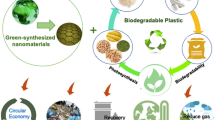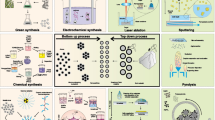Abstract
Cryochemical approaches have been used to synthesize hybrid systems consisting of a cryomodified β form of dioxydine (particle size of 30‒350 nm) and silver or copper nanoparticles (average size of 5‒18 nm). These hybrid composites and their precursors are incorporated into biopolymer cryostructures based on gelatin and calcium alginate. Hybrid composites based on metals and antibacterial drugs are very active in the inhibition of growth of E. coli 52, S. aureus 144, and M. cyaneum 98 in comparison with their separate components.
Similar content being viewed by others
References
A. Gupta, N. M. Saleh, R. Das, R. F. Landis, A. Bigdeli, K. Motamedchaboki, A. R. Campos, K. Pomeroy, M. Mahmoudi, and V. M. Rotello, “Synergistic antimicrobial therapy using nanoparticles and antibiotics for the treatment of multidrug-resistant bacterial infection,” Nano Futures 1, 015004 (2017).
P. Li, J. Li, C. Wu, and Q. Wu, “Synergistic antibacterial effects of ß-lactam antibiotic combined with silver nanoparticles,” Nanotechnology 16, 1912–1917 (2005).
X. Dong, M. Al. Awak, N. Tomlinson, Y. Tang, Y.-P. Sun, and L. Yang, “Antibacterial effects of carbon dots in combination with other antimicrobial reagents,” PLoS One 12, e0185324 (2017).
R. A. Mitran, L. Bajenaru, and M. G. Moisescu, “Controlling drug release from mesoporous silica through an amorphous, nanoconfined 1-tetradecanol layer,” Eur. J. Pharm. Biopharm. 127, 318–325 (2018).
C. Ding and Z. Li, “A review of drug release mechanisms from nanocarrier systems,” Mater. Sci. Eng., C 76, 1440–1453 (2017).
A. J. Sami, M. Khalid, T. Jamil, S. Aftab, S. A. Mangat, A. R. Shakoori, and S. Iqbal, “Formulation of novel chitosan guargum based hydrogels for sustained drug release of paracetamol,” Int. J. Biological Macromol. 108, 324–332 (2018).
T. Ito, T. Takami, Y. Uchida, and Y. Murakami, “Chitosan gel sheet containing drug carriers with controllable drug-release properties,” Colloid Surf., B 163, 257–265 (2018).
M. S. Hasnain, A. K. Nayak, M. Singh, M. Tabish, and J. Ara, “Alginate-based bipolymeric-nanobioceramic composite matrices for sustained drug release,” Int. J. Biol. Macromol. 83, 71–77 (2016).
R. Jalababu, S. Veni, and K. V. N. S. Reddy, “Synthesis and characterization of dual responsive sodium alginate- g-acryloyl phenylalanine-poly n-isopropyl acrylamide smart hydrogels for the controlled release of anticancer drug,” J. Drug Deliv. Sci. Technol. 44, 190–204 (2018).
R. A. Bini, M. F. Silva, L. C. Varanda, M. A. Silva, and C. A. Dreiss, “Soft nanocomposites of gelatin and poly(3-hydroxybutyrate) nanoparticles for dual drug release,” Colloid Surf., B 157, 191–198 (2017).
A. Talebian and A. Mansourian, “Release of vancomycin from electrospun gelatin/chitosan nanofibers,” Mater. Today: Proc. 4, 7065–7069 (2017).
O. I. Vernaya, V. V. Epishev, M. A. Markov, V. A. Nuzhdina, V. V. Fedorov, V. P. Shabatin, and T. I. Shabatina, “Synthesis of copper nanoparticles by thermal decomposition of anhydrous copper formate,” Mosc. Univ. Chem. Bull. 72, 267–268 (2017).
S. V. Saikova, S. A. Vorob’ev, R. B. Nikolaeva, and Yu. L. Mikhlin, “Conditions for the formation of copper nanoparticles by reduction of copper(II) ions with hydrazine hydrate solutions,” Russ. J. Gen. Chem. 80, 1122–1127 (2010).
V. I. Lozinsky, V. K. Kulakova, R. V. Ivanov, A. Yu. Petrenko, O. Yu. Rogulska, and Yu. A. Petrenko, “Cryostructuring of polymer systems 47. Preparation of wide porous gelatin-based cryostructurates in sterilizing organic media and assessment of the suitability of thus formed matrices as spongy scaffolds for 3D cell culturing,” E-Polymers 18, 172–176 (2018).
I. A. Rodionov, N. V. Grinberg, T. V. Burova, V. Ya. Grinberg, T. I. Shabatina, and V. I. Lozinsky, “Cryostructuring of polymer systems 44. Freeze-dried and then chemically cross-linked wide porous cryostructurates based on serum albumin,” E-Polymers 17, 263–274 (2017).
O. I. Vernaya, V. P. Shabatin, A. M. Semenov, and T. I. Shabatina, “Obtaining ultradispersed dioxidine powder modified,” Mosc. Univ. Chem. Bull. 71, 291–298 (2016).
O. I. Vernaya, V. P. Shabatin, T. I. Shabatina, D. I. Khvatov, A. M. Semenov, T. P. Yudina, and V. S. Danilov, “Cryochemical modification, activity, and toxicity of dioxidine,” Russ. J. Phys. Chem. A 91, 229–232 (2017).
O. I. Vernaya, D. I. Khvatov, A. V. Nuzhdina, V. V. Fedorov, V. P. Shabatin, A. M. Semenov, and T. I. Shabatina, “Cu/dioxidine hybrid nanocomposites,” Mosc. Univ. Chem. Bull. 71, 224–226 (2016).
O. I. Vernaya, V. P. Shabatin, A. M. Semenov, and T. I. Shabatina, “Cryochemical synthesis and antibacterial activity of a hybrid composition based on ag nanoparticles and dioxidine,” Mosc. Univ. Chem. Bull. 72, 6–9 (2017).
G. G. Onishchenko, “Determination of the sensitivity of microorganisms to antibacterial drugs,” Methodical Instructions (Moscow, 2004) [in Russian].
Author information
Authors and Affiliations
Corresponding author
Additional information
Original Russian Text © T.I. Shabatina, O.I. Vernaya, A.V. Nuzhdina, N.D. Zvukova, V.P. Shabatin, A.M. Semenov, V.I. Lozinskii, M.Ya. Mel’nikov, 2018, published in Rossiiskie Nanotekhnologii, 2018, Vol. 13, Nos. 3–4.
Rights and permissions
About this article
Cite this article
Shabatina, T.I., Vernaya, O.I., Nuzhdina, A.V. et al. Hybrid Nanosystems Based on an Antibacterial Preparation of Dioxydine and Metal Nanoparticles (Ag and Cu) Included in Biopolymer Cryostructures. Nanotechnol Russia 13, 182–188 (2018). https://doi.org/10.1134/S1995078018020106
Received:
Accepted:
Published:
Issue Date:
DOI: https://doi.org/10.1134/S1995078018020106




